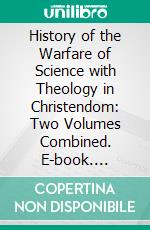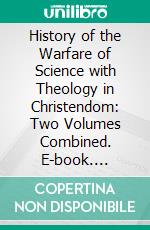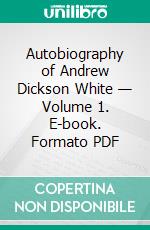History of the Warfare of Science with Theology in Christendom: Two Volumes Combined. E-book. Formato PDF - 9788832506105
di Andrew Dickson White
edito da IONLINESHOPPING.COM , 2019
Formato: PDF - Protezione: nessuna
A History of the Warfare of Science with Theology in Christendom was published in two volumes by Andrew Dickson White, a founder of Cornell University, in 1896.
In the introduction White states the original goal of his 1874 lecture on The Battlefields of Science and elaborated in a book The Warfare of Science the same year:
"In all modern history, interference with science in the supposed interest of religion, no matter how conscientious such interference may have been, has resulted in the direst evils both to religion and to science, and invariably; and, on the other hand, all untrammelled scientific investigation, no matter how dangerous to religion some of its stages may have seemed for the time to be, has invariably resulted in the highest good both of religion and of science."
In these volumes he chronicles the gradual emancipation of science from theology in various fields.
Chapter 1 From Creation to Evolution
The literal interpretation of Genesis, including denial of all death and of animals not of use to man before the introduction of sin, gives way to the recognition of the enormous number of species in the world. Various evolutionary ideas opposed progressively by Linnaeus, Cuvier and Agassiz led up to the theory of natural selection proposed by Darwin and Wallace. The initial theological opposition gradually gave way to compromise by most churches.
Chapter 2 Geography
The spherical ideas of Pythagoras, Plato and Aristotle had replaced earlier ideas from Chaldeans and Egyptians of a flat earth. The church fathers favoured the idea of a solid roof or firmament over the earth and this was elaborated early on, but in the Middle Ages most followed authorities such as Thomas Aquinas in accepting sphericity. Jerusalem was accepted as the centre of the world and a refusal to accept the existence of antipodes led many to assume that the other side of the world was entirely aqueous. Opposition to the antipodes did not cease for centuries after Magellan's voyages and also contributed to underestimates of the size of the earth, which happened to help Columbus. Religious feeling encouraged the expansion of Europeans across the globe.
Chapter 3 Astronomy
Despite earlier more literal ideas, the Ptolemaic view of a geocentric universe was fully adopted by the Church, adding an immovable heavenly sphere above the stars and hell below the earth. In the sixteenth century, Copernicus challenged this view but his book was not published until after his death, when it was given a preface suggesting that it was simply a hypothesis. When Galileo used his telescope to show other reasons for rejecting the Ptolemaic view he faced opposition from both Catholics and Protestants. He was forced to renounce his sun-centred view, which was not formally accepted by the Catholic church before the nineteenth century. In England attacks continued into the eighteenth.
In the introduction White states the original goal of his 1874 lecture on The Battlefields of Science and elaborated in a book The Warfare of Science the same year:
"In all modern history, interference with science in the supposed interest of religion, no matter how conscientious such interference may have been, has resulted in the direst evils both to religion and to science, and invariably; and, on the other hand, all untrammelled scientific investigation, no matter how dangerous to religion some of its stages may have seemed for the time to be, has invariably resulted in the highest good both of religion and of science."
In these volumes he chronicles the gradual emancipation of science from theology in various fields.
Chapter 1 From Creation to Evolution
The literal interpretation of Genesis, including denial of all death and of animals not of use to man before the introduction of sin, gives way to the recognition of the enormous number of species in the world. Various evolutionary ideas opposed progressively by Linnaeus, Cuvier and Agassiz led up to the theory of natural selection proposed by Darwin and Wallace. The initial theological opposition gradually gave way to compromise by most churches.
Chapter 2 Geography
The spherical ideas of Pythagoras, Plato and Aristotle had replaced earlier ideas from Chaldeans and Egyptians of a flat earth. The church fathers favoured the idea of a solid roof or firmament over the earth and this was elaborated early on, but in the Middle Ages most followed authorities such as Thomas Aquinas in accepting sphericity. Jerusalem was accepted as the centre of the world and a refusal to accept the existence of antipodes led many to assume that the other side of the world was entirely aqueous. Opposition to the antipodes did not cease for centuries after Magellan's voyages and also contributed to underestimates of the size of the earth, which happened to help Columbus. Religious feeling encouraged the expansion of Europeans across the globe.
Chapter 3 Astronomy
Despite earlier more literal ideas, the Ptolemaic view of a geocentric universe was fully adopted by the Church, adding an immovable heavenly sphere above the stars and hell below the earth. In the sixteenth century, Copernicus challenged this view but his book was not published until after his death, when it was given a preface suggesting that it was simply a hypothesis. When Galileo used his telescope to show other reasons for rejecting the Ptolemaic view he faced opposition from both Catholics and Protestants. He was forced to renounce his sun-centred view, which was not formally accepted by the Catholic church before the nineteenth century. In England attacks continued into the eighteenth.
Ean
9788832506105
Titolo
History of the Warfare of Science with Theology in Christendom: Two Volumes Combined. E-book. Formato PDF
Autore
Editore
Data Pubblicazione
2019
Formato
PDF
Protezione
nessuna
Punti Accumulabili




